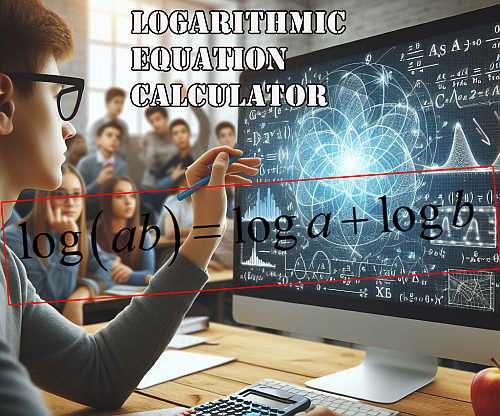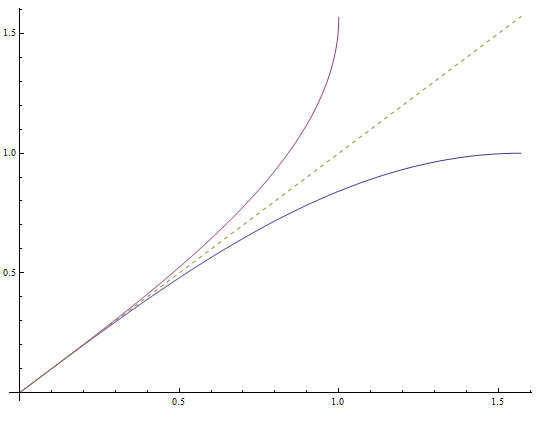Logarithmic Equation Calculator
Instructions: This calculator will help you solve logarithmic equations, showing all the steps. Please type in the logarithmic equation you need to solve in the box below.
Solving Logarithmic Equation
This logarithmic equation calculator with steps will allow you solve different types of logarithmic equations. One of the advantages of using this solver is that all the steps of the process will be shown to you. All you need to do is to type a valid log equation, such as for example 'ln(x) = ln(e^2)'.
Then, and once you are done typing (or pasting) the equation, you have to click on the "Solve" button so to get the solutions and steps shown to you.
Solving logarithmic equations is not hard usually, but it is largely depend on the equation you want to solve. Simple equations like ln(x) = 1 are super simple, and it is not hard to see that the solution is x = e. This solution is obtained by applying the exponential function "e" to both sides of the equality.
Having a general equation calculator can be extremely practical, but the expectation should be moderate, as some equations simply cannot be solved by elementary methods.

What is a Logarithmic Equation
A logarithmic equation is a type of algebra equation in which the unknown (typically x or y) goes inside of one of more logarithmic functions.
For example, a very simple logarithmic equation would be
\[\displaystyle \log_2(x+2) = \log_2(8) \]Since the unknown x appears in a log function (a log base 2 function in this example), then we have a logarithmic equation.
How do you solve Logarithmic Equations?
Solving logarithmic equations does not follow a set-in-stone sequence of steps, but instead, we need to be mindful of the logarithmic rules so to try to take that to our advantage.
- Step 1: Confirm whether or not the equation is logarithmic. Other types of equation will likely require a different approach
- Step 2: Identify all the log terms that contain the unknowns and put them all on one side of the equation
- Step 3: Use the log rules as much as possible to collapse all log expressions into one. This is not always possible, but often times it is
- Step 4: If you managed to put all logs together into one, you can cancel the logarithm using a suitable exponential function. For example, to cancel ln(x) you use the exponential e^x, to cancel log_2(x) you use 2^x, and so on
As you can see, the list of steps is simple and does not tell very strict rules. This is because in order to find the solution to a logaritmic equation your best chance is indeed getting rid of the logarithm, and get into the argument (which contain the unknown) .
Unlike other types like linear equations and quadratic equations, for which you have specific formulas and they can ALWAYS be solved, you cannot guarantee you will be able every single log equation. You may try to collapse the logarithms, you may try substitutions, but ultimately, you will find some that will resist all methods you can pull out your sleeve.
How Logarithmic Functions and Logarithmic Equations Related
There is a tight relationship between logarithmic functions and logarithmic equations, in that a log equation will have in general log functions in one or both sides of the equation equality.
That is why the properties of functions involving logarithms are so important. So indeed, making astute use of log rules can definely come in handy.

What uses do you find of logarithmic equations?
- Use 1: Deal with population and decay models
- Use 2: Profuse application of log equations in different areas of science (Chemistry, Physics, etc)
- Use 3: Uses in Finance, to compute the time to double an investment, among many other uses
Naturally, also Algebra and Calculus subjects will provide you with ample opportunities to practice anything related to logarithms.
Should I use the natural logarithm only?
One big source of confusion for students is the different types of logarithmic functions, as you have in general the log function with any positive base.
But the change of base formula for logarithms indicates that:
\[\displaystyle \log_a(x) = \frac{\ln(a)}{\ln(a)} \]What this is telling you is that any other log function, with any positive base is simply the natural log function times a constant. So they have essentially the same behavior. That is why often times log with other bases are disregarded by math instructors, because it can all be reduced trivially to natural log.

Example: Solving a logarithmic equation
Calculate the following: \(\ln(x^2+1) = 0\)
Solution: We apply the exponential function \(e^x\) to both sides of the equation, so we get:
\[\displaystyle e^{\ln(x^2+1)} = e^0\] \[\displaystyle \Rightarrow x^2+1 = 1\] \[\displaystyle \Rightarrow x^2 = 0\]so then \(x = 0\). If we plug this back into the original equation, we get \(\ln(0^2+1) = \ln(1) = 0\), which concludes the calculation.
More equation calculators
Equation calculators with steps will do a hard job, which is finding the right tool for the right equation structure. And the difficulty can come with unusual structures that do not lend themselves to any known approach.
For example, solving trigonometric equations can easily test you in all your wits, to find solutions. And even more complicated, trig expressions are periodic, so trig equations may have infinite solutions to deal with. When dealing with non-linear equations, each equation can be its own world.






